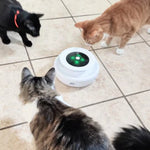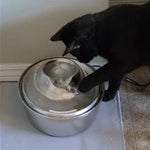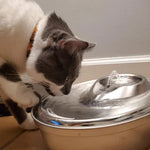Cats who are a healthy weight are happier, more agile, and tend to live longer. Obesity, which is generally viewed as 20 percent or more above normal weight, is the most frequently observed nutritional disorder in domestic cats and, in many cases, this is preventable! Why Is a Healthy Weight Important for Your Cat?Obesity can result in a reduced quality of life. Overweight cats tend to physically interact less with their families and are often less energetic, less playful, and more lethargic.They can also have an increased risk of developing a number of serious health conditions, including those listed below.Arthritis (the increased weight can place an excessive burden on joints, tendons, and ligaments).Urinary diseaseKidney diseaseHeart diseaseChronic inflammation High blood pressure (placing an added burden on the heart)Diabetes (as the body’s requirements for insulin exceed the body’s ability to produce or use it)Difficulty breathing (fat in the chest and abdomen can restrict the ability of the lungs to expand)Decreased immune functionConstipation and flatulenceSkin infectionsSome cancers have even been associated with obesityCauses of Cat Obesity Similar to humans, there are a variety of causes and contributing factors to obesity in cats, it isn't always as simple as just overfeeding. It’s important to identify if there are potential underlying medical causes for obesity prior to beginning a weight loss program.Some of the common causes of obesity in cats can include one or more of the following:OverfeedingGeneticsSedentary activity level/lack of exerciseSpaying or neuteringUnhealthy feeding habitsHypothyroidism Some medicationsCushing’s diseaseDiabetesStress PainHow To Help Your Cat Lose WeightManaging a weight loss programme for a cat usually involves a multifaceted approach, typically in conjunction with veterinary professionals.A healthy plan won't offer any quick fixes and it will involve you adjusting routines in and around the house to best support your cat. Some of the top tips for helping your cat to shed the pounds are detailed below.1. Rule Out Underlying Medical ConditionsThe most important aspect of any weight loss journey is to first establish if there are any underlying medical conditions that could be contributing to your cat's weight gain. Ruling out, identifying, and treating problems associated with weight gain is paramount.2. Listen to Your Vet's AdviceIf you haven't noticed your cat putting on a few pounds here and there, don't take offence if, at their annual exam, your vet comments that they could do with shedding a few pounds. Your vet knows what they are talking about and you should heed their advice.If no underlying causes for your cat's weight gain are apparent, your vet will typically recommend an overall suggested weight loss to work towards gradually. In extreme cases, they may recommend a special prescription weight-loss diet. Regular weigh-ins at their clinic to monitor progress may also be suggested.3. Consider What You Are Feeding Your CatThe quality of over-the-counter cat foods varies dramatically. Some can have unnecessary added sugars, others are particularly high in fat.Canned food is lower in calories than dry kibble, contains a large amount of water, is easier for your cat to digest, and many cats enjoy it. Some owners choose to switch to feeding a larger proportion of wet food in comparison to dry as part of the programme. There are also over-the-counter weight-loss diets available in pet stores. These are not designed to have a miraculous effect and measuring of quantities is still required, but they can help in a small way.Take a look at what you are currently feeding your cat and make a gradual change over if you discover it is not as healthy as you thought. Your vet or a qualified pet nutritionist can offer additional advice if needed.4. Measure Out Your Cat's Daily Food AllowanceA very common cause of cats being overweight is simply them being overfed. A great starting point is to begin by measuring their daily portions with a cup or scales. Transition away from free feeding, which is leaving food out all the time, and gradually move towards scheduled feedings. When there’s a bottomless bowl of food you have no way of monitoring how much each cat is eating. It may seem convenient at first, but it is a leading cause of obesity. As you make the transition away from free-feeding start by doing more frequent, scheduled, smaller meals and making a big announcement when it’s mealtime so the kitties can get used to the new routine. You could also consider using an automatic feeder that dispenses a measured amount of food at pre-programmed times.Creating individual feeding stations for your cats can be helpful as well. Cats are not big fans of eating together, can have resource guarding issues, and mealtime should not be a stressful experience.5. Plan Daily Play Sessions for Increased ExerciseIn addition to monitoring calorie intake and providing quality nutrition, exercise is crucial to a healthy weight for your cat. There are lots of options, such as cat exercise wheels, for encouraging your cat to exercise—even if they don't venture outdoors.Exercising their prey drive with interactive play is a crucial part of your cat’s development and contributes greatly to their quality of life. It is also a wonderful way to exercise your cats.Scheduled playtimes occur within the same hour or two every day and provide your cat with structure and a consistent schedule. It is a good idea to have a variety of interactive toys available at all times, and some that are kept specially for play sessions.Having two or three wand or mouse on a string toys that only come out during these times will help to keep them novel and fun. These are great for simulating prey and help tap into your cat's natural drives.It's really important to let your cat "catch" their prey during the play session. Otherwise, they will get frustrated and either stop playing with you or act out in response to her unfulfilled urges. If you play with a laser pointer, be sure to have some kitty play sessions with a toy she can catch, too.6. Use Puzzle Toys and FeedersPuzzle feeders help to slow down greedy eaters, prevent boredom, and can provide additional exercise. They allow cats to eat more instinctively by allowing them to forage and “hunt” for their food.There are various food dispensing toys for cats that you can purchase, and you can even make your own. Start with an easy puzzle and work up to more difficult types based on your individual cat’s preference. Some easy DIY puzzle feeding options include:Paper bags: put catnip, catnip covered toy mice, treats or pieces of dry kibble inside a lunch bag. Your cat can explore, pounce, and kill (destroy the bag) It’s a great hiding space and a fun toy all at the same time.Paper towel roll inners: cut a paper towel roll in half, fold in the ends and cut a few small to large holes. You can then place dry food or low-fat treats inside. As your cat begins to use these more, cut smaller holes to make it more of a challenge.Water bottles: Take empty water bottles, remove the wrapper, cut a few small to large holes and add some treats. You can leave the lid on or off for increasing difficulty for this DIY puzzle toy· 7. Regularly Assess ProgressKeep a written log of food intake (including all treats), exercise, and weekly weight. Weigh your cat on the same scale at the same time of day every week. It is sometimes helpful to plot out this information (dates and weights) on a graph.Remember, you may hit 'plateaus' in which your cat seems stuck at a certain weight. This is common. Do not despair, but continue with the weight reduction program, making sure no one in the household is 'cheating.'Typical minimum weight loss per month for a healthy adult act is 0.5-lbs. Ideally, your cat will lose close to one pound per month. Some cats may need to go slower, while others may shed the pounds more quickly. 8. Don't Give In to BeggingChanges should be gradual and at a pace your cat is comfortable with, but sometimes feeding a little less can cause your cat to vocalize and perform other attention-seeking behaviors to beg for food.Providing you are following the weight loss programme properly, your cat has access to plenty of fresh water, and there are no underlying health issues, then it is important not to cave in. Remember you are doing this to, ultimately, improve your cat's overall health and quality of life.













